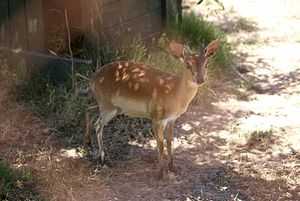Tygerberg Zoo
|
A suni at the Tygerberg Zoo in 2007 | |
| Date opened | 1979 |
|---|---|
| Date closed | 2012 |
| Location | Approx. 40 mi (64 km) from Cape Town, South Africa[1] |
| Coordinates | 33°46′01″S 18°42′54″E / 33.766861°S 18.715128°ECoordinates: 33°46′01″S 18°42′54″E / 33.766861°S 18.715128°E |
| Land area | 24 ha (59 acres) |
Tygerberg Zoo was a 24-hectare (59-acre) zoo near Stellenbosch, South Africa, the only zoo in the Western Cape province and the closest to Cape Town. It was privately-run. It was established in 1979, operated for 33 years, and closed in 2012.[2] It was "once a major tourist attraction and a hot spot for school educational outings" according to Cape Times coverage of its closure.[3] Featured animals included chimpanzees and tigers, lions, and cheetahs. The zoo had 160 bird species and 63 reptile species, and "specialised in breeding rare and endangered animals."[1]
The zoo was notable for its breeding successes, including the 1998 birth of "the world’s tiniest tortoise", a baby Namaqua Speckled.[2]
It is also attracted international attention for John Spence's finding lions in captivity in Russia that were covered in the news as possible descendants of the extinct Cape lion species, and his bringing two of them back to the Tygerberg Zoo. Cape lions were a black-maned, large, and otherwise distinctive species of lion native to South Africa. They were hunted to extinction in the wild in the 1850s and soon believed to have no survivors in captivity. John Spence was long intrigued by stories of Cape lions, including their scaling the walls of General van Riebeeck's castle in the 17th century (Jan van Riebeeck (1619-1670) was the founder of Cape Town.) Spence believed some Cape Lions might have been taken to Europe and interbred with other lions. He spent 30 years searching zoos and circuses world-wide, for lions that looked like Cape lions,[4] until a friend sent photographs of lions in the Novosibirsk Zoo in Novosibirsk, Russia that did, in 2000. A black-maned lion named Simon, descended from lions the zoo acquired in 1961, perhaps from a traveling circus, was the best specimen. He was exactly like Cape lions' in paintings (the only images available) that Spence had studied.[5] John and Lorraine Spence visited and, with assistance of a Vienna zoo,[4] were allowed to bring two of Simon's cubs back to Tygerberg Zoo.[2][6]
News coverage during 2000-2001 included titles such as the National Geographic News' "Has Rare Lion of Africa's Cape Eluded Extinction?", for its July 2001 story on Cape lions and John Spence's long search. Shortly before that, National Geographic Today featured a documentary special on the topic. [7]
Filmed at Tygerberg Zoo in 2001, John Spence explained he hoped to breed lions for the Cape area that looked like Cape lions, but avoided saying the cubs were descendants. He also expressed interest in having DNA-testing done to compare the cubs' DNA to surviving Cape lion DNA,[4] but there was never any news of that happening.
History
A predecessor zoo was founded by John Spence and Geoff McLachlan at Kraaifontein in the outskirts of Cape Town in 1966. This zoo was soon moved, and at its peak had 61 mammal species and 160 bird species. It addressed a void created by decline and closure of the obsolete Groote Schuur Zoo, established in 1897 and known also as the Cape Town Zoo, that had been designed in a completely different era. The Groote Schuur Zoo fully closed in 1975.[8]
The Tygerberg Zoo was established on its 24-acre property in 1979 by John Spence. Lorraine Spence met John in 1985, and came to the zoo later. John was director before his death in 2010; Lorraine, then director, announced and managed its closing in 2012. The zoo had 24 workers, four of whom lived on the property, in 2012.[2]
John Spence died in 2010.[2]
The zoo's closure in 2012 was, according to Lorraine Spence, due to decline of visitors during its last ten years, and expenses of animal feed and salaries, that made it no longer financially viable.[2][9] The zoo's animals were to be dispersed to other zoos and to farms.[2] Drakenstein Lion Park, also outside Cape Town, is one zoo that did receive many. It purpose-built and opened a modern facility for chimpanzees and small animals from Tygerberg.[3][10] Drakenstein also was expected to receive Tygerberg's tigers and lions,[3] presumably including the two from Novosibirsk, who were still there.[2]
Visitation was high on weekends before the scheduled closure. The last day Tygerberg Zoo was to be open for visitors was 4 November 2012.[9]
References
- ↑ 1.0 1.1 Western Cape Extended, 2012
- ↑ 2.0 2.1 2.2 2.3 2.4 2.5 2.6 2.7 Rebecca Davis (4 June 2012). "We lost a zoo: Western Cape's only zoo closes". Daily Maverick. Retrieved 2015-03-30.
- ↑ 3.0 3.1 3.2 Aziz Hartley (31 March 2012). "Tygerberg Zoo sold". Cape Times.
- ↑ 4.0 4.1 4.2 "South Africa: Lion Cubs Thought to Be Cape Lions". AP Archive, of the Associated Press. 8 November 2000. (with 2-minute video of cubs at zoo with John Spence, 3 sound-bites, and 15 photos)
- ↑ San Dieqo Zoo newsletter brief in 2001, which uses term "look-alike"]
- ↑ 'Extinct' lions (Cape lion) surface in Siberia. BBC News (2000-11-05). Retrieved on 2012-12-31 and 2015-03-30.
- ↑ Ron Irwin (26 July 2001). "Has Rare Lion of Africa's Cape Eluded Extinction?". National Geographic News. (note mention of documentary is past end of article, on article's page 2.)
- ↑ Sean O'Toole (21 December 2012). "The closing of Tygerberg Zoo". Mail & Guardian.
- ↑ 9.0 9.1 "A Dream Dies - Tyberberg Zoo Closes: The animal sanctuary near Paarl is shutting its gates for good this time". Eyewitness News. 2012-11-01. Retrieved 2012-11-01. (the Eyewitness News located in Johannesburg and Cape Town)
- ↑ "Drakenstein Lion Park is now home to a new facility, Chimp Haven". Drakenstein Lion Park.
